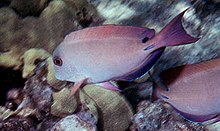Acanthurus nigrofuscus
| Acanthurus nigrofuscus | |
|---|---|

| |
| Scientific classification | |
| Kingdom: | Animalia |
| Phylum: | Chordata |
| Class: | Actinopterygii |
| Order: | Acanthuriformes |
| Family: | Acanthuridae |
| Genus: | Acanthurus |
| Species: | A. nigrofuscus
|
| Binomial name | |
| Acanthurus nigrofuscus (Forsskål, 1775)
| |
Acanthurus nigrofuscus, also known as the lavender tang, brown tang, or spot-cheeked surgeonfish, is a tang from the Indo-Pacific and Hawaii. It commonly makes its way into the aquarium trade. It grows to 21 cm in length.[2] Recently, a huge bacterium discovered in its intestine, Epulopiscium fishelsoni,[3][4] has been found to grow as large as 600 by 80 μm, a little smaller than a printed hyphen, which controls the pH of its host's gut, thereby influencing its host's ability to digest food and absorb nutrients.
Diet[]
The lavender tang is an herbivore that grazes primarily on benthic algae. In captivity, they will also feed on animal matter such as brine shrimp and mysis shrimp.
References[]
- ^ Choat, J.H.; McIlwain, J.; Abesamis, R.; Clements, K.D.; Myers, R.; Nanola, C.; Rocha, L.A.; Russell, B.; Stockwell, B. (2012). "Acanthurus nigrofuscus". IUCN Red List of Threatened Species. 2012: e.T178019A1523035. doi:10.2305/IUCN.UK.2012.RLTS.T178019A1523035.en. Retrieved 20 November 2021.
- ^ "Archived copy". Archived from the original on February 28, 2014. Retrieved May 13, 2015.CS1 maint: archived copy as title (link)
- ^ Angert ER, Clements KD, Pace NR (1993). "The largest bacterium". Nature. 362 (6417): 239–241. doi:10.1038/362239a0. PMID 8459849.
- ^ Angert ER, Brooks AE, Pace NR (1996). "Phylogenetic analysis of Metabacterium polyspora: Clues to the evolutionary origin of Epulopiscium spp., the largest bacteria". Journal of Bacteriology. 178 (5): 1451–6. PMC 177821. PMID 8631724.
- Froese, Rainer; Pauly, Daniel (eds.) (2008). "Acanthurus nigrofuscus" in FishBase. December 2008 version.
External links[]
- Photos of Acanthurus nigrofuscus on Sealife Collection
Categories:
- IUCN Red List least concern species
- Acanthuridae
- Acanthurus
- Fish of Asia
- Fish of Palau
- Fish described in 1775
- Taxa named by Peter Forsskål
- Acanthuridae stubs
